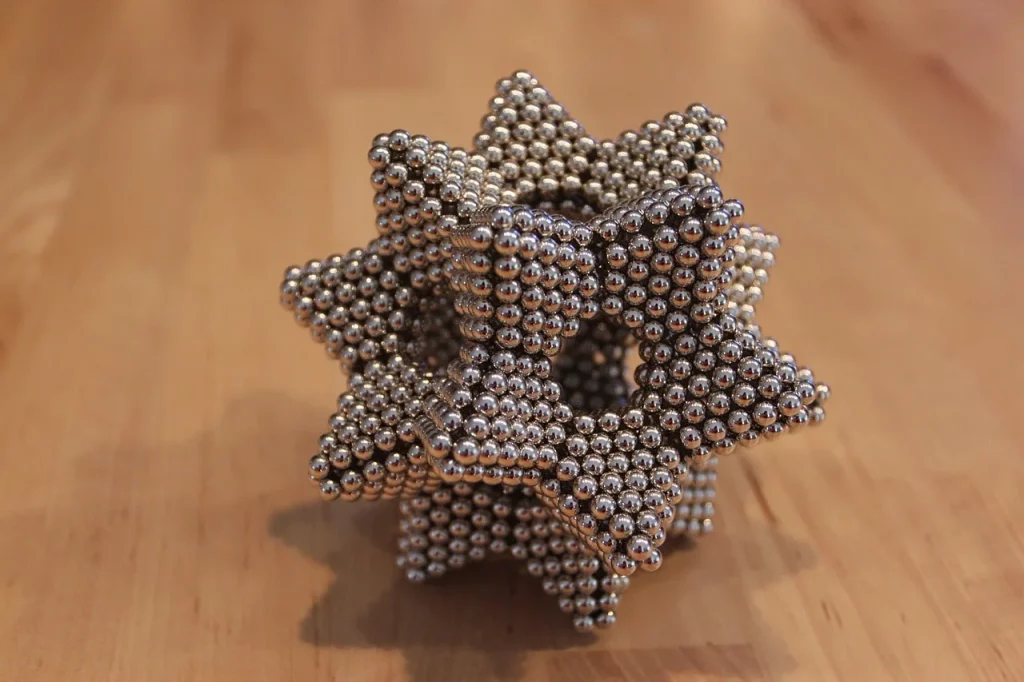Have you ever played with magnets, trying to force two of the same poles together, feeling that invisible push as if they’re saying, “Please, not another family reunion“? It’s a fun experiment that shows just a glimpse of the magnetic world.
Beyond this playful interaction lies a universe of magnetic wonders that power our technology, heal our bodies, and even guide animals across the globe. As we embark on a journey through all these magnet facts, we’ll uncover the hidden roles they play in our lives.
Magnets are one of the best examples that everything in life is connected.
Leonardo da Vinci
Magnet Facts
Let’s explore the captivating realm of magnets together. Make sure to absorb every fact, as a quiz at the end will offer you the chance to showcase your expertise in magnetism.
- The strongest magnetic field produced in a laboratory is a million times stronger than the Earth’s magnetic field.
- Natural magnets were first discovered in ancient Greece, in a region known as Magnesia.
- The Earth itself acts as a giant magnet, with a magnetic core that creates a protective magnetic field around the planet.
- Superconductors, materials that can conduct electricity with zero resistance, can also expel magnetic fields, a phenomenon known as the Meissner effect.
- Some animals, such as pigeons, sharks, and bees, can sense the Earth’s magnetic field and use it for navigation.
- The term magnetism comes from the word Magnesia, the name of the place where magnets were first found.
- Neodymium magnets, made from an alloy of neodymium, iron, and boron, are the strongest type of permanent magnets known.
- Magnetic fields can penetrate non-magnetic materials, allowing magnets to attract objects through walls of certain thicknesses.
- Magnetic levitation (maglev) trains use magnetism to float above tracks, eliminating friction and allowing for higher speeds.
- The sun’s surface is home to powerful magnetic fields, which are responsible for phenomena such as solar flares and sunspots.
- Electromagnets gain their magnetic properties only when electric current flows through them, unlike permanent magnets.
- The magnetic north pole of the Earth is actually a south magnetic pole because it attracts the north pole of magnetic compasses.
- Vortex rings made of spinning plasma can create magnetic fields, a principle that could impact future technologies.

- Quantum levitation allows objects to float stably above a magnetic track through the locking of magnetic fields.
- Galaxies, including the Milky Way, have their own magnetic fields, though they are much weaker than those found on Earth.
- Auroras, natural light displays in the Earth’s sky, are caused by the collision of solar wind particles with the Earth’s magnetic field.
- MRI machines use strong magnetic fields and radio waves to create detailed images of the body without using harmful radiation.
- In the 12th century, the Chinese invented the compass, one of the first practical uses of magnetic fields for navigation.
- Wireless charging technologies rely on magnetic induction to transfer energy without direct electrical contact.
- Materials classified as ferromagnetic can be permanently magnetized, including iron, nickel, and cobalt.
- Spintronics, a technology for data storage, utilizes the magnetic spin of electrons to store data more efficiently than traditional methods.
- The Van Allen radiation belts surrounding the Earth are formed by charged particles trapped by the Earth’s magnetic field.
- Magnetic fields are invisible but can be visualized using iron filings, which align along the lines of force.
- Magnetic refrigeration is an emerging technology that uses magnetic fields to cool materials without refrigerants, offering a greener alternative to traditional cooling methods.
- Monopoles, hypothetical particles with only one magnetic pole, have been postulated but never observed in nature.
- The Curie temperature is the point at which a material loses its permanent magnetic properties due to the disordering of its magnetic domains.
- Geomagnetic storms, caused by solar activity, can disrupt Earth’s magnetic field, affecting power grids and satellite communications.
- The Halbach array is a special arrangement of permanent magnets that enhances the magnetic field on one side while canceling it on the other side.

- Storing magnets improperly by not keeping their poles aligned can gradually decrease their strength.
- Magnetic therapy, though widely marketed for pain relief, lacks conclusive scientific evidence to support its efficacy.
- Nanomagnets are being researched for potential applications in medicine, including targeted drug delivery and cancer treatment.
- The Zeeman effect is the splitting of a spectral line into several components in the presence of a static magnetic field.
- Magnetars, a type of neutron star, have the strongest magnetic fields known in the universe, billions of times stronger than any man-made magnet.
- Magnetic ink used in the printing of currency enables the authentication of banknotes through magnetic detection.
- Magnetic nanoparticles can be directed using magnetic fields for environmental cleanup by removing pollutants from water.
- The Earth’s magnetic field has been reversed multiple times throughout history, with the poles switching places.
- Yttrium barium copper oxide is a high-temperature superconductor that can achieve superconductivity and magnetic levitation above liquid nitrogen temperature.
- Ferrofluids, liquids that become strongly magnetized in the presence of a magnetic field, are used in electronics, medicine, and engineering.

- Magnetic resonance is a principle also used in nuclear magnetic resonance spectroscopy for analyzing molecular and material structure.
- Gauss is a unit of measure for magnetic field strength, named after Carl Friedrich Gauss, who made significant contributions to the study of magnetism.
- The magnetic declination at a given location is the angle between the geographic north and the direction a compass needle points.
- Electromagnetic pulses (EMP) can be caused by natural phenomena or human-made devices and can disrupt electronic equipment over large areas.
- Materials with negative magnetic permeability can produce metamaterials that bend magnetic fields in unusual ways, leading to potential applications in cloaking devices.
- The Kondo effect is a phenomenon observed in some metals where resistance increases as temperature decreases due to interactions between conduction electrons and magnetic impurities.
- Magnetic fields can influence plant growth, with some studies showing accelerated growth rates under specific magnetic conditions.
- The Biot-Savart Law is a fundamental equation describing the magnetic field generated by a current-carrying conductor.
- Permanent magnets can lose their magnetism when heated above their Curie temperature or subjected to a strong opposing magnetic field.
- Magnetostriction is a property of ferromagnetic materials that causes them to change shape or dimensions in the presence of a magnetic field, a principle used in various sensors and actuators.
- Magnetohydrodynamics (MHD) studies the dynamics of electrically conducting fluids in magnetic fields, with applications ranging from astrophysics to nuclear fusion research.
- Magnetic nanoparticles are explored for their potential to store digital data at densities far greater than current hard drives, possibly revolutionizing data storage technology.
Magnet Myths

Now that we’ve explored all these facts about magnets, let’s venture further to distinguish fact from fiction. In the following section, we’ll dispel common myths and see what the actual truth is.
- Magnets Can Erase All Types of Data Storage
Contrary to popular belief, not all data storage devices are vulnerable to being wiped by magnets. Solid-state drives (SSDs), which are commonly used today, are not affected by magnets. This myth primarily pertains to magnetic storage media, like hard disk drives (HDDs), where powerful magnets could indeed cause damage. - Magnets Are Only Made of Iron, Nickel, and Cobalt
While iron, nickel, and cobalt are famously known to be magnetic, they are not the only materials from which magnets can be made. An array of materials, including certain types of ceramics and alloys, can be magnetized. Modern research has also led to the development of powerful rare earth magnets, like neodymium magnets, which are significantly stronger than traditional iron-based magnets. - Magnets Work Permanently Once Magnetized
It’s often thought that once an object is magnetized, it retains its magnetism indefinitely. However, over time, magnets can lose their magnetism. Exposure to heat, striking, or even the passage of time can cause magnets to become weaker. Special treatments are required to maintain a magnet’s strength over long periods of time. - Magnets Can Heal Various Illnesses
Magnetic therapy is a controversial subject. While it is marketed as a treatment for various conditions, scientific evidence supporting the effectiveness of magnets in healing is limited. It is important to consult healthcare professionals for medical conditions, as relying solely on magnetic therapy is not advised by the medical community. - The North Pole of a Magnet Always Points to the Geographic North Pole
This is a misunderstanding of Earth’s magnetic field. The north pole of a magnet actually points towards the magnetic north pole of Earth, which is not the same as the geographic north pole. Moreover, Earth’s magnetic north pole is not static; it wanders due to changes in the planet’s magnetic field.
No products found.
Magnet Quotes

Let’s delve into the world of magnetism through the words of those who have been fascinated by its power.
The magnetic force is that which communicates itself at a distance, and so mysteriously.
James Clerk Maxwell
James Clerk Maxwell, a scientist known for his work in electromagnetism, marveled at the invisible, yet powerful, force exerted by magnets.
I have often said that the lure of flying is the lure of beauty, but I need not really have said it. It is the same with the magnets. If you cannot feel the allure of both, you are probably insensible to either.
Amelia Earhart
Amelia Earhart, a pioneering aviator, drew parallels between the allure of flying and the mysterious appeal of magnetic forces, highlighting their innate beauty.
Electricity is really just organized lightning, just as a magnet is organized iron.
George Carlin
George Carlin, a comedian known for his keen observations, humorously simplified complex phenomena, likening electricity to lightning and magnets to organized iron.
The study of magnetic phenomena is an assemblage of delightful puzzles.
Michael Faraday
Michael Faraday, a scientist renowned for his contributions to electromagnetic theory, regarded the study of magnetic phenomena as a collection of intriguing and enjoyable challenges.
Magnetism, as you recall from physics class, is a powerful force that causes certain items to be attracted to refrigerators.
Dave Barry
Dave Barry, a humorist, playfully reduced the complex concept of magnetism to the simple, everyday occurrence of items sticking to refrigerators.
Magnet FAQ

As we draw closer to the conclusion of our magnetic journey, the next segment offers a crucial FAQ. Before you tackle the upcoming quiz, read these answers carefully to solidify your understanding.
- Will magnets stick to aluminum?
Nope, they won’t stick to aluminum. Aluminum is a non-ferromagnetic material, which means it doesn’t have the property that allows it to be attracted by a magnet. So, if you’re trying to stick a fridge magnet on an aluminum surface, it’s not going to stay put. - Why do magnets attract each other?
They attract each other because of magnetic fields. Each magnet has a north pole and a south pole. Opposite poles (north and south) attract each other, while the same poles (north-north or south-south) repel each other. It’s like the magnet’s way of finding its best match! - Can a magnet damage a laptop?
Yes, a strong magnet can potentially damage a laptop. While many parts of a laptop are immune to magnets, the hard drive (if it’s a traditional HDD) can be affected because it uses magnetic fields to store data. Keep those fridge magnets away from your computer! - Do magnets work underwater?
Water doesn’t affect the magnetic field, so magnets work just as well underwater as they do in the air. Whether you’re doing a science experiment in a pool or exploring magnetic forces in the ocean, water’s no barrier to magnetic attraction. - Can you make a non-magnetic material magnetic?
In some cases, yes. Through a process called magnetization, certain non-magnetic materials that have magnetic properties (like iron) can become magnetized when exposed to a strong magnetic field. However, materials that don’t have these magnetic properties (like plastic or wood) won’t become magnetic, no matter how hard you try.
No products found.
Magnet Quiz

Welcome to the Magnetic Quiz! Be warned; if you don’t stick to any answers correctly, you might just find yourself repelled from victory.
Conclusion
Our journey has been nothing short of magnetic. From the earth’s core to the devices in our pockets, these silent forces play a critical role in our lives, demonstrating the beauty and mystery of the physical world.
Magnets remind us that there’s always more to discover, pushing us to explore the unseen and understand its influence on the seen. They’re a perfect example of how even the smallest components of nature can have a vast impact, encouraging us to keep questioning and learning. Till next time, stay curious. Cheers.
3 Sources Used For This Article

